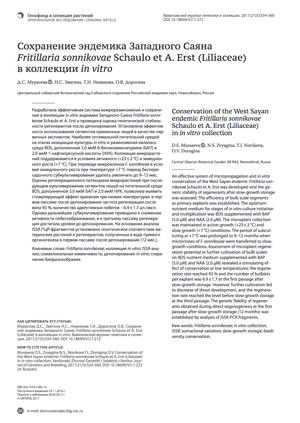NEWS 2017
Сохранение эндемика Западного Саяна Fritillaria sonnikovae Schaulo et A. Erst (Liliaceae) в коллекции in vitro
Conservation of the West Sayan endemic Fritillaria sonnikovae Schaulo et A. Erst (Liliaceae) in in vitro collection (in Russian)
Д.С. Мурасева, Н.С. Звягина, Т.И. Новикова, О.В. Дорогина
D.S. Muraseva, N.S. Zvyagina, T.I. Novikova, O.V. Dorogina
Вавиловский журнал генетики и селекции 21(5): 554-560 (2017)
Vavilov Journal of Genetics and Breeding
doi.org/10.18699/VJ17.272
Центральный сибирский ботанический сад Сибирского отделения Российской академии наук, Новосибирск, Россия
Central Siberian Botanical Garden SB RAS, Novosibirsk, Russia
Abstract
An effective system of micropropagation and in vitro conservation of the West Sayan endemic Fritillaria sonnikovae Schaulo et A. Erst was developed and the genetic stability of regenerants after slow-growth storage was assessed. The efficiency of bulb scale segments as primary explants was established. The optimum nutrient medium for stages of in vitro culture initiation and multiplication was BDS supplemented with BAP (5.0 μM) and NAA (2.0 μM). The microplant collection was maintained in active-growth (+23 ±2°С) and slow-growth (+7°С) conditions. The period of subculturing at +7°С was prolonged to 9–12 months when microclones of F. sonnikovae were transferred to slow-growth conditions. Assessment of microplant regeneration potential in further cultivation of bulb scales on BDS nutrient medium supplemented with BAP (5.0 μM) and NAA (2.0 μM) revealed a stimulating effect of conservation at low temperatures: the regeneration rate reached 93 % and the number of bulblets per explant was 6.9 ±1.7 at the first passage after slow-growth storage. However, further cultivation led to decrease of shoot development, and the regeneration rate reached the level before slow-growth storage at the third passage. The genetic fidelity of regenerants obtained during direct organogenesis at the first passage after slow-growth storage (12 months) was established by analysis of ISSR-PCR-fragments.




